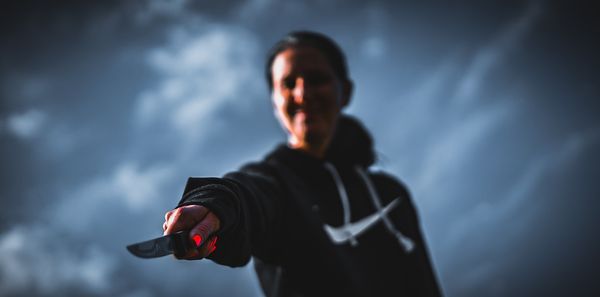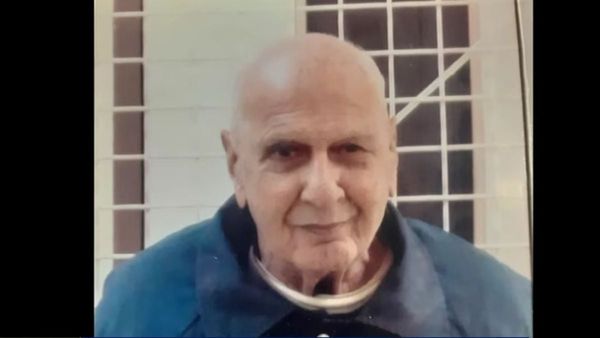
All of Willow’s dog toys have one ear. Tattered, misshapen, with synthetic stuffing poking out of them, they are scattered around an otherwise immaculate front room in north-west Norfolk, a telltale sign that a puppy lives in the house. There are other signs too: a new lead on a hook in the hallway; a still shining food bowl in the kitchen; a plush, hardly slept-in dog bed by the sofa.
Willow the golden retriever isn’t actually a puppy – she is three. But, as far as her new owners can tell, she never got the chance to spend her youth tearing the extremities off dog toys. So now she’s making up for lost time.
Willow, who previously went by a different name, was brought by her former owner to the Grove veterinary practice in Fakenham, north Norfolk, one morning in late September. She was filthy, the dirt stark against her creamy white fur. She was also in labour and in trouble. The vets prepped her for surgery, an emergency caesarean, but it was too late for five of her puppies, who had already died inside her. A further four were delivered alive while Willow was under general anaesthetic, although one later died while still at the surgery.
Mid-operation, the vets had a decision to make. Willow, dangerously ill, needed to be spayed but her owner had to give his consent for the procedure – and agree to Willow’s £3,000 vet bill. Despite repeated phone calls, the vets couldn’t get hold of him. Eventually, just as the hospital director Debbie Abraham had decreed the procedure could go ahead anyway, contact was made. The owner gave his permission but said he couldn’t afford to pay and, as a result, would not be coming to collect his dog. And so, as Willow came round from surgery, she and her remaining puppies were signed over to the Grove, which, three days later, gave them to a local rehoming centre run by the animal welfare charity RSPCA. Willow’s search for a new home had begun.
There are many possible reasons that this particular owner decided not to collect his dog that day, but Abraham suggests it may have been because he was breeding puppies for profit. “My opinion – not fact in any way, shape or form – is that with only four puppies alive and a three-grand bill, that wouldn’t cover the cost,” she says. Maybe Willow’s spaying contributed to the decision: “The chain stops.”
Willow’s story, or what we know of it, is, sadly, not unique, and cases like hers are just one reason that animal shelters across the UK are at breaking point. Brexit, the pandemic and a cost of living crisis have led to what the RSPCA calls “a winter crisis”, with animal abandonments hitting a three-year high, likely to total more than 21,000 for 2023. Meanwhile, as bills go up, shelters are becoming more expensive to run.

The West Norfolk RSPCA rehoming centre, where Willow and her puppies were taken in September, is full. All 20 kennels are occupied, with some containing two dogs if they have been brought in together, although even animals that have previously lived side by side can get stressed and begin to fight in a kennel environment. The centre also has two holding pens, each housing a litter of puppies, and four isolation kennels for dogs that need to be kept apart. It is licensed to accommodate up to 36 cats and eight feline mothers with litters too. The cattery has been at capacity since April.
As well as the animals on site, the centre has an army of fosterers – volunteers who temporarily take home animals that struggle in a shelter. There’s still a waiting list, says Carl Saunders, the shelter’s general manager. The centre manager Emily Cole nods in agreement and estimates that six out of 10 animals that come in from homes – as opposed to being found as strays – are brought in because their owners can’t afford them.
The pair lead me through to the holding pens, where I am greeted with deafening yapping. The puppies wag their tails and press their tiny noses against the bars of the kennels, inviting me to pet them as they squeak with giddy excitement. Over the din, Saunders begins to unpick the situation. “During Covid, there was a massive spike in demand for puppies, and people were paying stupid amounts of money for them,” he says. “I reckon over 90% of the puppies being bred were not in any way licensed.” Worse, a vet shortage caused by Brexit – last year the British Veterinary Association said the number of new EU registrants coming to work in the UK had fallen by more than two-thirds between 2019 and 2021 – means there are fewer vets available to sterilise animals, a particular problem with free-roaming cats. “A kitten is fertile from about four months,” says Saunders. “And within four weeks of having a litter, they can have another one.”
Owners often haven’t got a clue what they’re taking on, he says, especially with brachycephalic (flat-faced) breeds such as French bulldogs, the second most popular dog in the UK in 2022, according to the Kennel Club. “They have terrible breathing problems. The simplest of nasal or soft palate operations can cost between £1,200 and £1,500. When people are spending £200 or £300 a month on their electricity, where are they going to get the money?” More often than not, he adds, animals that come in aren’t insured, with many owners admitting they let their insurance lapse because they could no longer afford the monthly bill. Feeding pets can also be a stretch; the RSPCA already delivers pet food to food banks in the north of England and plans to expand the project across England and Wales in 2024.
While desperately needing the rehoming crisis to abate, the shelter staff are keen for struggling owners to approach them for help. Saunders is quick to stress that there’s no shame in surrendering your animal. “If it hasn’t worked out, it’s not your fault. It’s also not your fault if you can’t afford a £2,000 operation you weren’t expecting.”

Animal charities are naturally keen for anyone considering getting a pet to rescue rather than buy. To encourage this, a number of organisations, including the RSPCA, now offer a lifetime guarantee. “If anything changes in that household and they can’t cope with one of our adopted animals any longer, we will always take that animal back in,” says Cole. “It doesn’t matter if it’s been out for 10 weeks or 10 years.” Later in my visit, I see a dog who had left the shelter three years earlier being returned by an owner whose circumstances have changed. The handover is calm, respectful and agonising to watch.
It’s not always like that, though. “Some people are so distraught they almost have to go out in a bucket,” says Saunders. “Others just don’t care.” The impression I get, after talking to Abraham and the staff at the shelter, is that Willow’s former owners fell into the “don’t care” category, which is hard to stomach for the people involved in her recovery.

Just days after Willow arrived, it became clear she had picked up an infection and needed additional surgery. By the time she was well enough to leave the vets, her milk had dried up and her remaining two puppies – one had, sadly, succumbed to the same infection – had to be taken away to be hand-reared by one of the centre’s volunteers.
Liz Jackson admits to being daunted by the task. “I’d never hand-reared any animal before and, although I’ve had children of my own and fostered over 80 children, I’ve never actually bottle-fed, so making up feeds was a new experience.” But that was only the tip of the iceberg. The puppies relied on her entirely, even needing help going to the toilet. Initially, they required feeding and toileting every hour, which meant Jackson was up throughout the night. “Being there when they opened their eyes was wonderful. They would normally be with their mother and you wouldn’t get to witness these things,” she says, adding she lost count of the number of times she was asked if she was keeping them. “Like with fostering children, I knew I was just providing care up to a certain point. But I must admit, I was really sad when I had to leave them. It was such a wrench.”
When the puppies were five weeks old, Jackson handed them over to a member of staff at the centre, Debi Dennis. Every day, until they were ready to leave for their new homes, Dennis packed the puppies into her car and drove them to work with her. There, they would spend the day in the office in a puppy pen – they couldn’t venture farther afield until they’d had their vaccinations – being doted on by besotted volunteers. They were nine weeks old when I met them on my visit to the centre – pleasingly cuddly bundles of bright white fur who were far more relaxed in the presence of humans than the shrill, excited puppies I had encountered in the holding pen. “They’re used to humans more than their mum,” Dennis explained, a revelation that was both sweet and sad.
In the end, in a turn of events worthy of a Richard Curtis film, the puppies were adopted by the veterinary staff who saved them, one of the adopters being Abraham, who first held her new puppy when she was just hours old. “It’s really special, isn’t it?” she says. “It’s like we have managed to save her and then provide her with a life.”
Willow’s story has a happy ending too. While recuperating at the centre, she was spotted by a volunteer “cat-cuddler”, Rosie McAllister, who had only signed up to help six months earlier. “I decided to volunteer with the cats because I didn’t trust myself not to fall in love with the dogs,” she tells me with a smile and a glance at Willow, who is sitting timidly in the gap between an armchair and a sofa. Willow is withdrawn when we visit and seems reluctant to emerge from her safe space. Progress with her is slow but steady, says McAllister, with whom Willow has clearly formed a close bond. “She’s happiest next to me,” she says, reaching down to gently stroke Willow’s head. “I don’t really get an awful lot done.” McAllister, who is retired, has slept downstairs with Willow since she arrived four weeks ago and says she is a different dog at night. “She’s got her tail wagging, she’s running around, she comes up and nudges me. She eats her food at night; she won’t eat food in the day.”

Curiosities like this have led McAllister and her partner, Alan McDade, to speculate grimly as to where – and what – Willow has come from. McDade describes how, when Willow first arrived, she used to bolt through open doors. “You had visions of, as she was coming through a door, was somebody … ?” He pauses, grimaces, and mimes kicking a dog through a door frame.
Whatever life Willow lived before, McAllister is certain she was never allowed to be a puppy. This is perhaps why she is so proud of Willow’s one-eared toys, holding each one up to show me, inviting me to inspect the loose threads where the ears once were. This is tangible, if slightly soggy, evidence that Willow’s new life has begun. As Britain’s animal shelters continue to fill up, you can only hope that more toys will soon lose their ears too.







